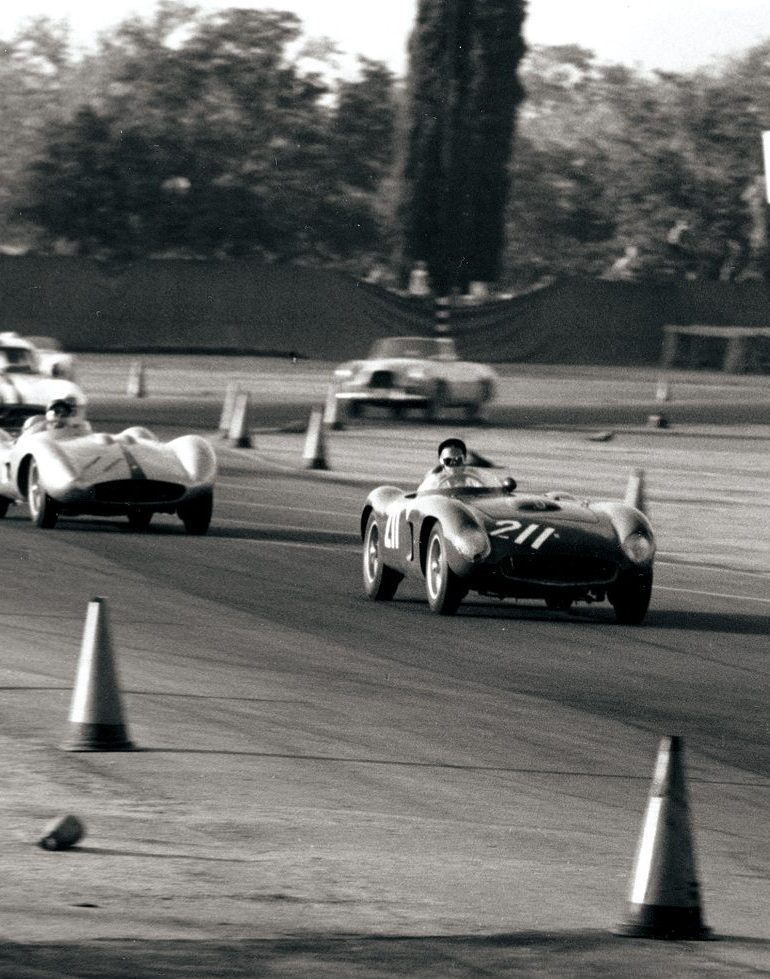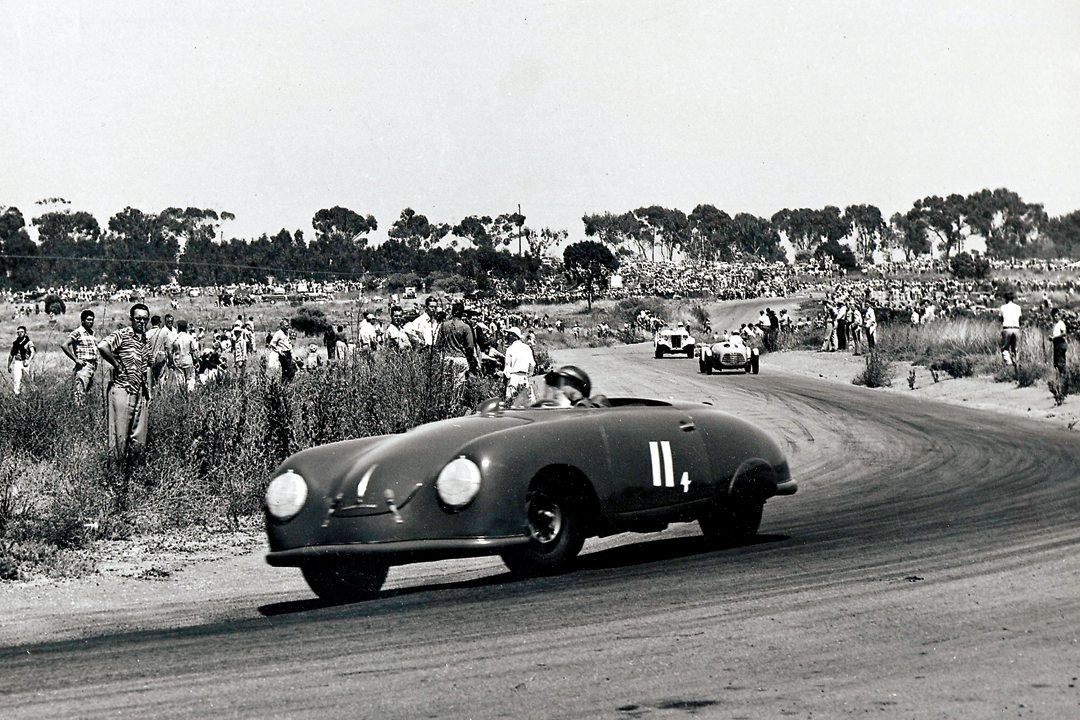
John Von Neumann was one of those towering figures in the sports car world of the ’50s. He was one of the founders of the California Sports Car Club that eventually became the largest Region of the SCCA. He pioneered Porsche in the Western U.S., not only in racing, but also as daily drivers. He was also instrumental in helping elevate Ferrari to the top of the heap. And he was my friend.
One day during the ’90s, my kids and I were playing in the pool at our home on Rose Avenue in Palm Springs. My wife came out and said, “Hey, did you hear, our neighbor Johnny (Von Neumann) was kidnapped?” “What happened,” I asked, “is he okay?” “Yes,” she said, “they set him free and he’s back home now.” She had heard about it from a neighbor, Anna Polak (Vasek’s wife). All three of us had homes on the same street then.
Shortly afterward, we visited with John. He told us what happened: He was attacked in his house, bound and gagged, and put in the trunk of his Rolls-Royce. After being driven somewhere, he didn’t know where, he was taken into a strange house and told to get ransom. So he called his business manager, Sam Weil, and, according to Sam’s secretary, Mary Rundal, $3 million in cash was delivered. After about a week, John was released along with his Rolls.
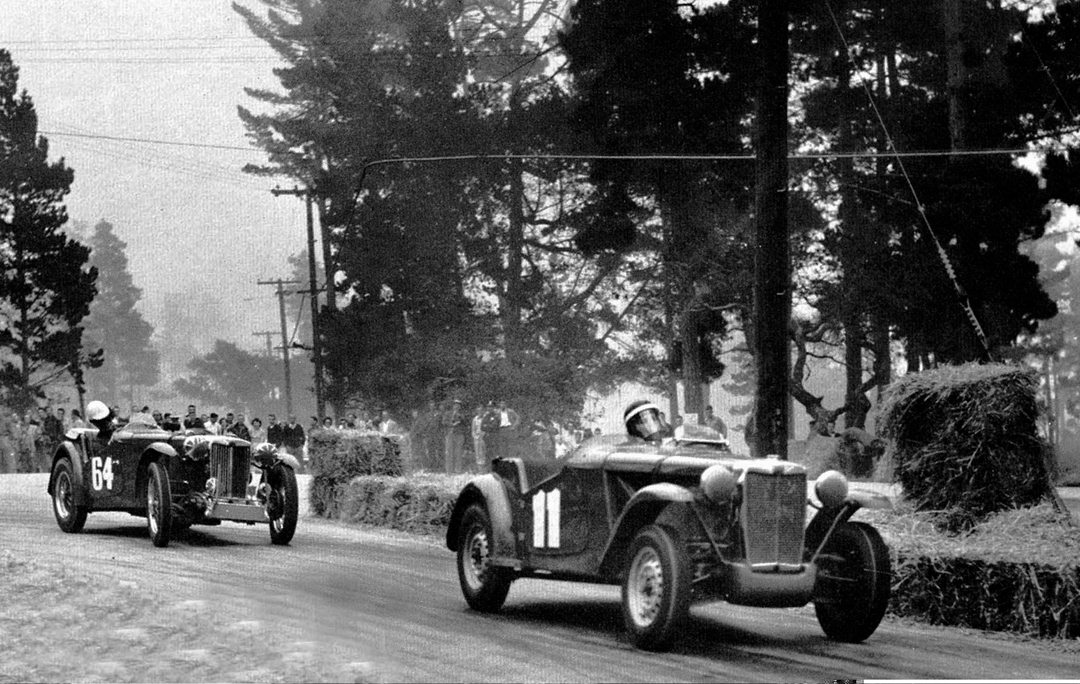
The whole affair was kept very quiet with nothing in the press. This happened sometime after he had sold his Porsche and VW distributorships back to the companies. According to a mutual friend with whom I talked about this, $3 million by then was chump change for John.
John Michael Neumann was born in Vienna, Austria on December 16, 1921. His father was Heinrich Neumann von Héthárs, born in 1873 in Héthárs, Hungary (now part of Slovakia). The “von” means “from” indicating where he was born. In Germany, “von” indicates titled nobility. This was certainly not the case for Neumann, an Austrian Jew. Heinrich studied at the University of Vienna and was awarded a doctorate of medicine in 1898. He became a world famous physician and was the foremost ear, nose and throat doctor in Vienna before WWII. Among his patients were King Edward VIII of England and King Alfonso XIII of Spain.
One time during the ’30s, Dr. Neumann was contacted by German doctors to treat Hitler, who was suffering from a larynx problem. He refused. Neumann also defended the rescue of Austrian Jews at the Conference of Evian in 1938. To put it mildly, he was not a favorite among Nazis, who by then were a significant factor in Austria. With war looming, Dr. Neumann stashed a lot of his assets in Canada. In addition, he got one of his patients, Bernard Baruch (who was close to President Roosevelt) to help him obtain visas to the U.S. Even then Johnny was enthralled with cars. He remembered riding his bicycle to visit Max Hoffman’s Vienna showroom. Hoffman later moved to New York, becoming an early foreign car importer.
On March 12, 1938, Germany occupied and annexed Austria. (As an aside: Austrian Chancellor Kurt Schuschnigg resisted the Anschluss, as the takeover was called, and was imprisoned. After the war, he emigrated to the U.S. and became a college professor. I studied modern European history under him at USC, straight from the horse’s mouth, as it were.) Dr. Neumann was also imprisoned, but managed to escape.
John, his father and mother, Maelitta, moved to New York City where Dr. Neumann had been offered a lectureship at the Presbyterian Hospital in Columbia University. They had an apartment on Park Avenue where Maelitta ended up living for the rest of her life. John’s two older sisters, Anne Marie and Lisalotte had stayed behind in Geneva, Switzerland. Later, they were able to travel to Genoa, Italy, where they secured passage to the U.S. Unfortunately, Dr. Neumann died on November 6, 1939. Johnny was only 18 years old. Due to Dr. Neumann’s foresight in sequestering funds in Canada, John was left what he called, “Quite a bit of money.”
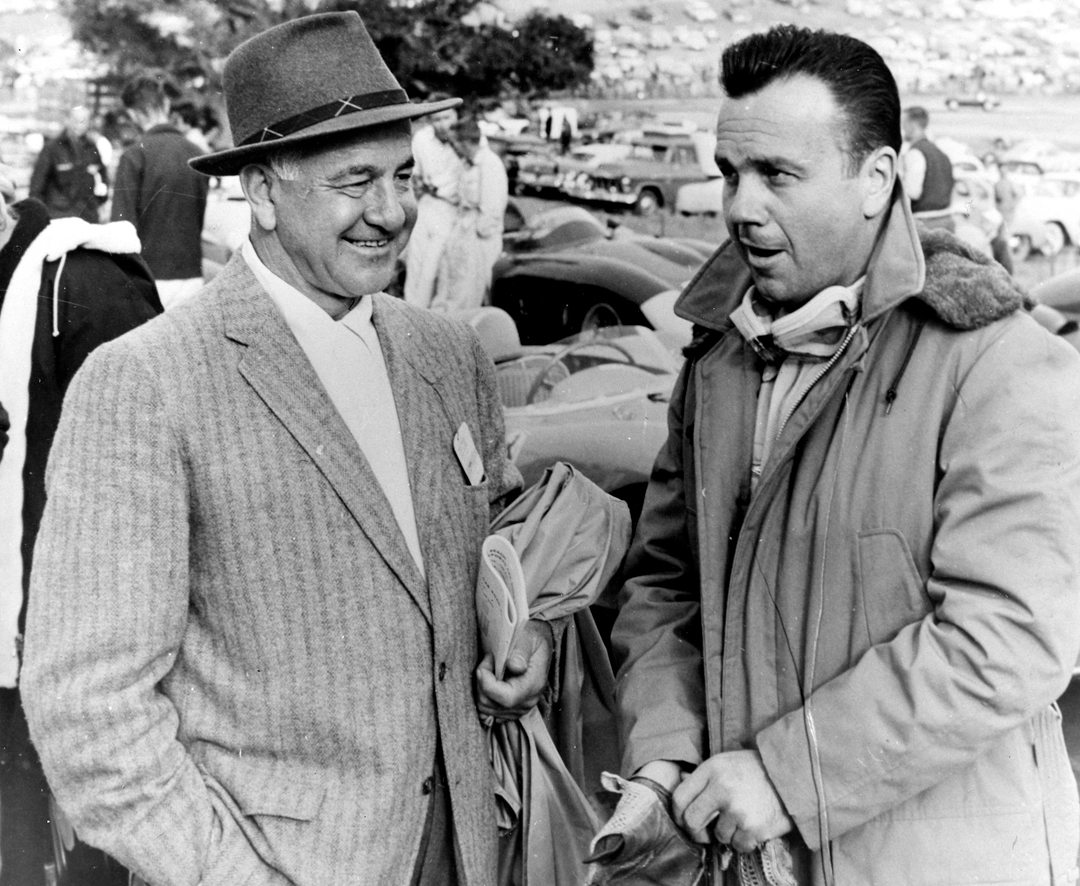
Always enamored with cars, John bought a Talbot Figoni-Falaschi Teardrop Coupe from Max Hoffman, who by then had a showroom in New York City. An aficionado of the musical theater and a “stage-door Johnny,” young Neumann became enamored with a beautiful Ziegfeld dancer, Elinor Bigelow. Elinor was somewhat older than John and had a daughter, Josie, from a previous marriage to Joe Bigelow, a well-known radio and TV writer. (Bigelow’s writing credits include the Jack Benny, Edgar Bergen and Fred Allen shows among a number of others.) John and Josie had a few seemingly similar facial characteristics and some assumed he was actually her father.
According to school records, John Michael Neumann enrolled in the 1940 fall semester at New York University, majoring in Civil Engineering. (John was also accepted at Princeton, but decided on NYU because Princeton had a rule forbidding freshmen from having cars.) After completing the spring semester, he drove his Talbot to California and enrolled in the 1941 fall semester at the University of Southern California. After the war started, he enlisted in the U.S. Army early in 1942. (Note: I have been unable to verify John’s war records using the Army’s official electronic site. Even so, I don’t doubt his service. I understand that a fire destroyed quite a number of WWII records before they could be digitized.)
John later related: “I went into the U.S. Infantry and took basic training at Camp Callan, just north of San Diego. (After the war, the camp was decommissioned. We know it as Torrey Pines, where John raced during the ’50s on the streets where he had formerly marched.) I was sent overseas in 1944. First, I was sent to France where I acquired a girlfriend and measurably improved my French. Due to my German-language skill, I was assigned to Army intelligence where I worked interrogating German prisoners. During that time, I was wounded by shrapnel and awarded the Purple Heart. After the surrender, I was posted with the military government in Salzburg, Austria, where I worked as an investigator and interviewer in the de-Nazification program.” After being discharged in 1946, he returned to New York where he married Elinor Bigelow.
The next year, they moved to Southern California and John assumed the name of Von Neumann. (In some accounts, he has been referred to as “von,” with a lower-case “v.” Had he been German, a “von” in his name would have indicated he was of the German nobility, but of course, this was not the case.)
Due to his enthusiasm for exotic cars, John got a job as a salesman at a foreign car dealership on Sunset Boulevard in Hollywood called International Motors. It was owned and operated by Roger Barlow. Johnny remembered selling Phil Hill an MGTC.
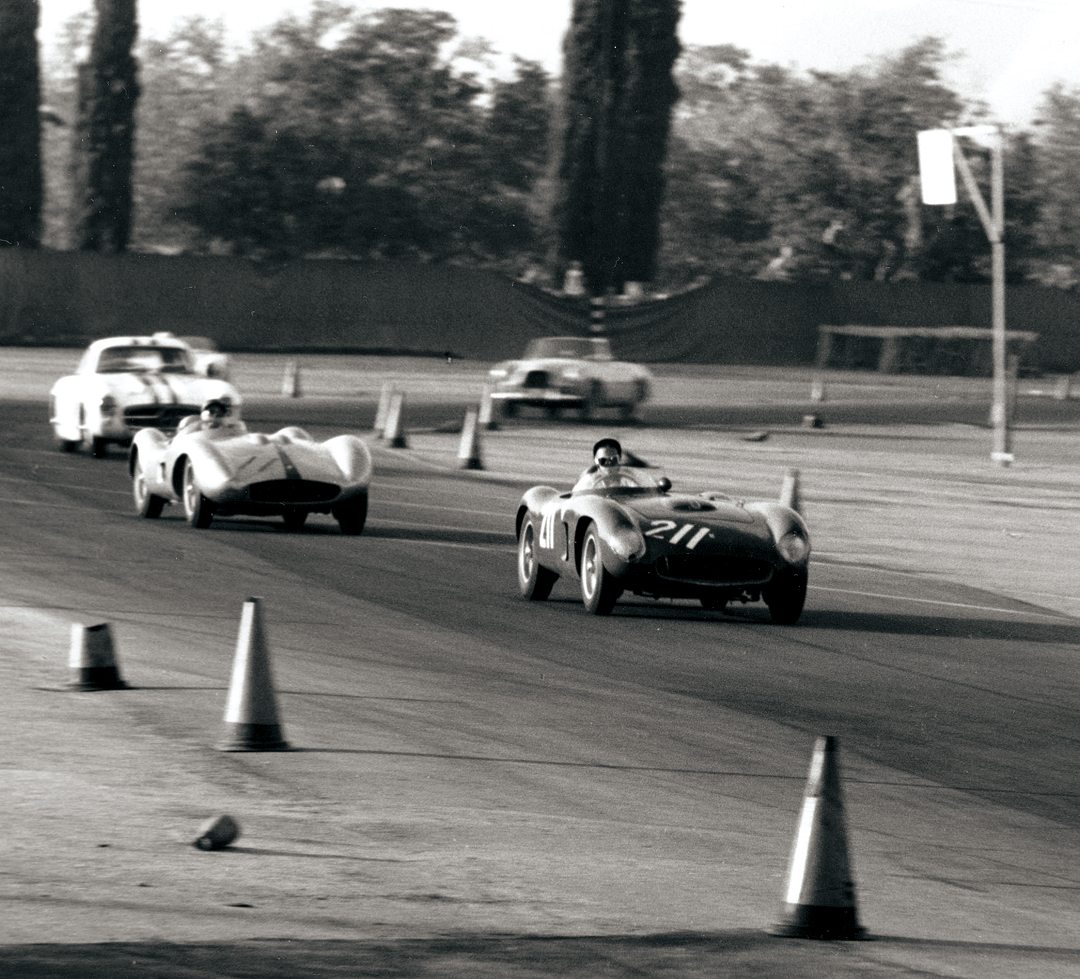
In 1947, three enthusiasts got the idea of forming a sports car club in Southern California: Roger Barlow, Taylor Lucas (also an International Motors employee) and John Von Neumann. At the time, some foreign car enthusiasts had gatherings in the area. At a get together in Santa Barbara in 1947, Roger and John urged the group to organize a hill climb. The activity, however, was voted down because most thought it too dangerous. Whereupon, Barlow, Lucas and Von Neumann with their wives walked out and went for a drive, Roger in his Talbot-Darracq, Taylor in his Hotchkiss and John in his SS100 Jaguar. They stopped at the top of the San Marcos Pass, overlooking Santa Barbara and the Pacific Ocean. “While breathing the aroma of hot tires, smoking brakes and over-warm engine oil,” John remembered, “We decided to put together a club solely devoted to motor racing.”
Soon thereafter, an organizing meeting took place in Los Angeles. Jack Early, Phil Hill, Vilem Haan, Bill Pollack and a few others joined the three original instigators. So the California Sports Car Club was born on a date in 1947 now lost in the mists of time.
The first Cal Club event on August 31, 1947 was held on the then mostly undeveloped hills of Palos Verdes. It was a time trial on paved public roads. Probably the police didn’t notice what was happening at such a remote location. None of those who participated can recall which roads were used, but John Von Neumann remembered the ocean and Catalina Island as a backdrop, so obviously they were on the southwestern slope. John set the best time in his SS100 Jaguar.
Meanwhile, at International Motors, and according to John, “Roger and I competed for who could sell the most cars. But I wasn’t getting my commissions. One day, I mentioned this to a customer—Secondo Gausti—who offered to back me if I opened my own dealership.” Not long afterward, John took Gausti up on his offer and, in 1948, opened a speed shop that included the sale of used foreign cars. It was on Ventura Boulevard in North Hollywood and he called it Competition Motors. Secondo—or Sec as he was called—later sold out to John for the princely sum of $900.
Another early event was called the “Centro Miglia.” It was an illegal open road race held, at night, in the hills north of Los Angeles near Saugus. Approximately 100 miles long, it started at the beginning of Bouquet Canyon Road and ended at Tips, a restaurant near Castaic. The competition was Von Neumann’s idea. Elinor was the timer and scorekeeper, flagging them off at one-minute intervals. When all had gone, she would drive over to Tips and log the finishes. Bill Pollack remembers that Von Neumann had a Lea Francis convertible, while all the others were in MGTCs. The event was held a number of times during 1948.
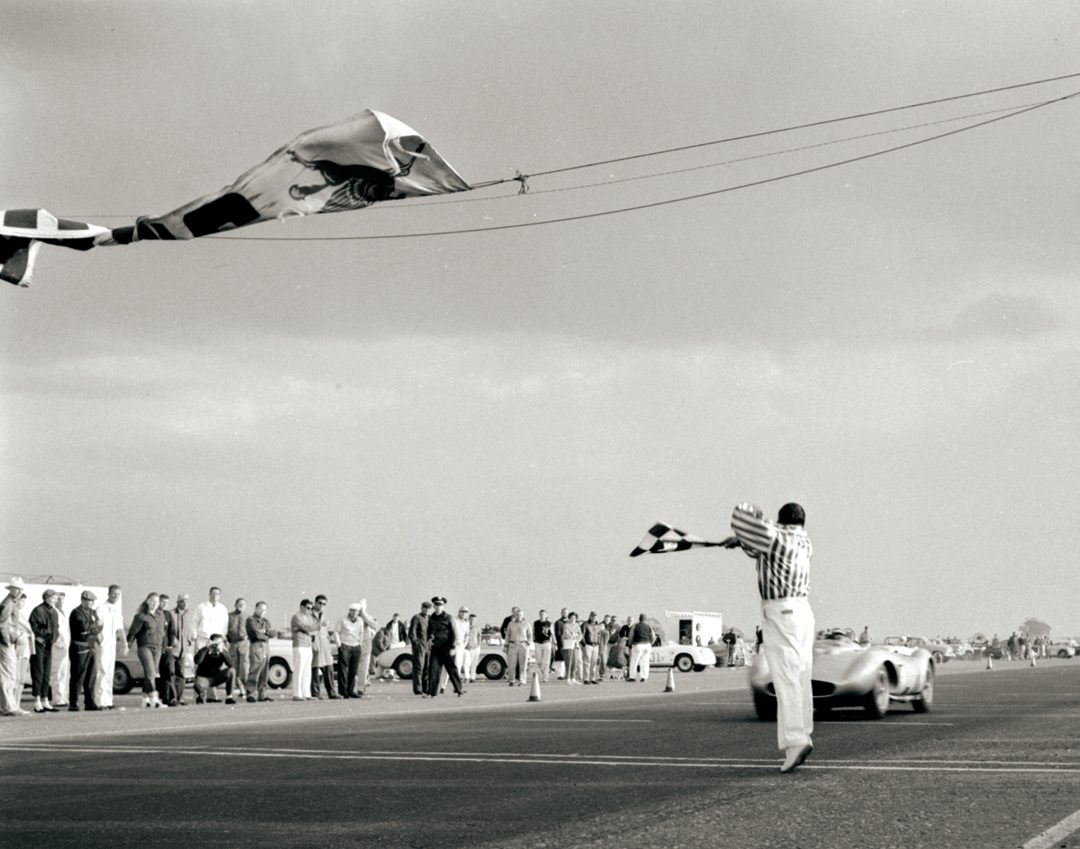
On November 14, 1948, and again on December 5, 1948, time trials were held on a 3/10-mile test track at the Davis Motorcar Company in the San Fernando Valley. Roger Barlow in his Talbot-Fagoni won the first one. Phil Hill won the MG class with John Von Neumann 2nd. Sec Gausti in a supercharged Alfa Romeo 8C2300, formerly owned by Tazio Nuvolari, won the December event.
During the summer of 1949, a time trial was held in Goleta, just north of Santa Barbara. The ¾-mile course was laid out at what used to be a Marine Corps Air Station (now the Santa Barbara Airport) where Von Neumann drove his Talbot Coupe.
The Cal Club ran a number of wheel-to-wheel races during the ’40s at Carrell Speedway, a ½-mile oval in Gardena, a suburb of Los Angeles. The first was held on July 24, 1949. The Speedway had frequent professional races plus occasional amateur sports car events. Von Neumann always took part.
The first road race in Southern California was at Palm Springs on April 16, 1950 organized by the Cal Club. It’s interesting to note that two of the officials were pre-war racing greats. The Chief Steward was Ralph De Palma (1915 Indy winner) and the Starter was Peter De Paolo (1925 Indy winner). Cal Club officials included founders Taylor Lucas, Roger Barlow and John Von Neumann.
Practice was held all day Saturday, April 15. Johnny blew the head gasket in his supercharged MG, so he borrowed a Riley to compete in the main event. The first race on Sunday was ten laps for novices, 16 of whom were on the grid, including Bill Pollack. He remembers the entry fee was $20. Bill had an MGTC, but he was afraid its 52 horsepower wouldn’t be a threat to more powerful cars. So he remembered that, “My friend and mechanic, John Von Neumann, suggested a supercharger. John just happened to have a new Shorrock unit for which he charged $325 installed. At the start, my TC jumped out in front and I was never threatened.” So Bill had the honor of winning the very first event. (See Bill’s book, Red Wheels and White Sidewalls, 2004, Brown Fox Books.)
The 40-lap main event hosted a mixed bag of cars. Jack McAfee drove Tony Parravano’s Cadillac convertible. Bill Pollack remembers, “It was very hot and a lot of cars fell by the wayside.” Sterling Edwards led in his V8-60 Special with E. Forbes (Robbie) Robinson’s MGTD 2nd. I ended up 3rd.” Von Neumann didn’t finish because the borrowed Riley ran out of gas.
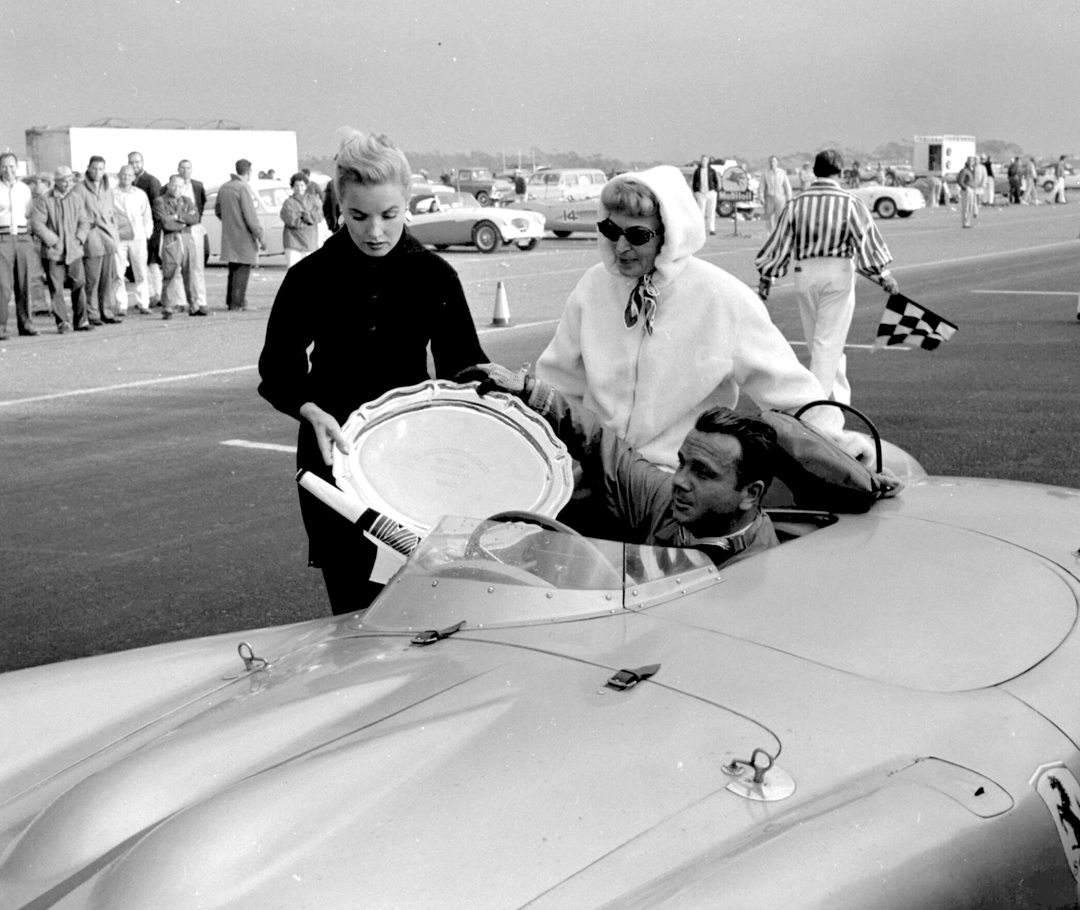
The first race ever held at Pebble Beach took place on November 5, 1950. Von Neumann entered his modified MGTD and won the very first event—the Cypress Point Light Car Race—for cars under 1500-cc. The first race at Torrey Pines was on December 9, 1951. The course used roads originally built for Camp Callan. Johnny entered the MG. Josie Von Neumann, in her first race, ran away with the “Ladies Handicap Race” in his MG. Later that day, Johnny blew the MG’s engine during the main event.
In early 1952, John went to New York and bought a Porsche Le Mans coupe from Max Hoffman, drove it back to California and entered the May 20 race at Pebble Beach. Pushing the Porsche hard, he led at first, but his brakes faded and he failed to finish. Next, he drove to San Francisco and entered the first Golden Gate race on May 30. Again, he had problems—this time the Porsche overheated—and the best he could manage was 16th. Back home, Johnny had maestro Emil Diedt cut the top off and form an aluminum tonneau cover. After considerable mechanical work, John won the main event for cars under 1500-cc at the second running of Torrey Pines on July 20. In doing so, he defeated his old employer, Roger Barlow in his Simca Special, who finished 2nd. Previously, the Simca had been dominant at West Coast events. This sparked an interest in others to buy Porsches, which John set about satisfying.
Bill Pollack remembers John for bringing Porsches to the West Coast: “John and Elinor would fly back to New York, buy two cars from Max Hoffman, and drive them back to Los Angeles.” Eventually, John arranged for cars to be shipped by rail and secured a Porsche dealership from Hoffman. Jim Sitz remembers that his wife, Dorothy Dean, loaned John the necessary funds, but Dorothy told Johnny that, “The real money is in VWs!”
“In January 1952 I opened the first Porsche agency in Southern California,” Johnny recalled, “then in 1953 I acquired the exclusive VW distributorship for Southern California and moved to a Vine Street location in Hollywood.” Later that year he added a Porsche distributorship. By the end of 1955, Von Neumann was the Porsche and VW distributor for Southern California, Southern Nevada, Arizona and Hawaii. During 1956, Competition Motors shipped some 10,000 cars to 37 dealerships.
Through the 1954 season, Von Neumann competed in Porsches, taking home a number of trophies. He ran a 550 Porsche Spyder, first at Bergstrom Air Force Base and then at Pebble Beach in April where he was 2nd in the under-1500-cc main event. Later that year, he bought his first Ferrari—an ex-Porfirio Rubirosa Mondial—and from then on mostly raced different models of that marque.
Porsches needed promotion, however, so Ken Miles—then the top small-car pilot in his MG Specials—was hired in 1955. Ken’s first outing for Von Neumann was at Torrey Pines on January 14-15, 1956. During practice on Saturday, Miles managed to flip the 550 on the last turn and total it. Luckily, he was not injured. Von Neumann had another Spyder delivered from Competition Motors and on Sunday, Ken not only won the semi-main for under 1500-cc cars, but also came in 3rd behind Masten Gregory in a Maserati and Ernie McAfee in a Ferrari in the main event itself. Von Neumann himself was 4th in his Ferrari Monza.
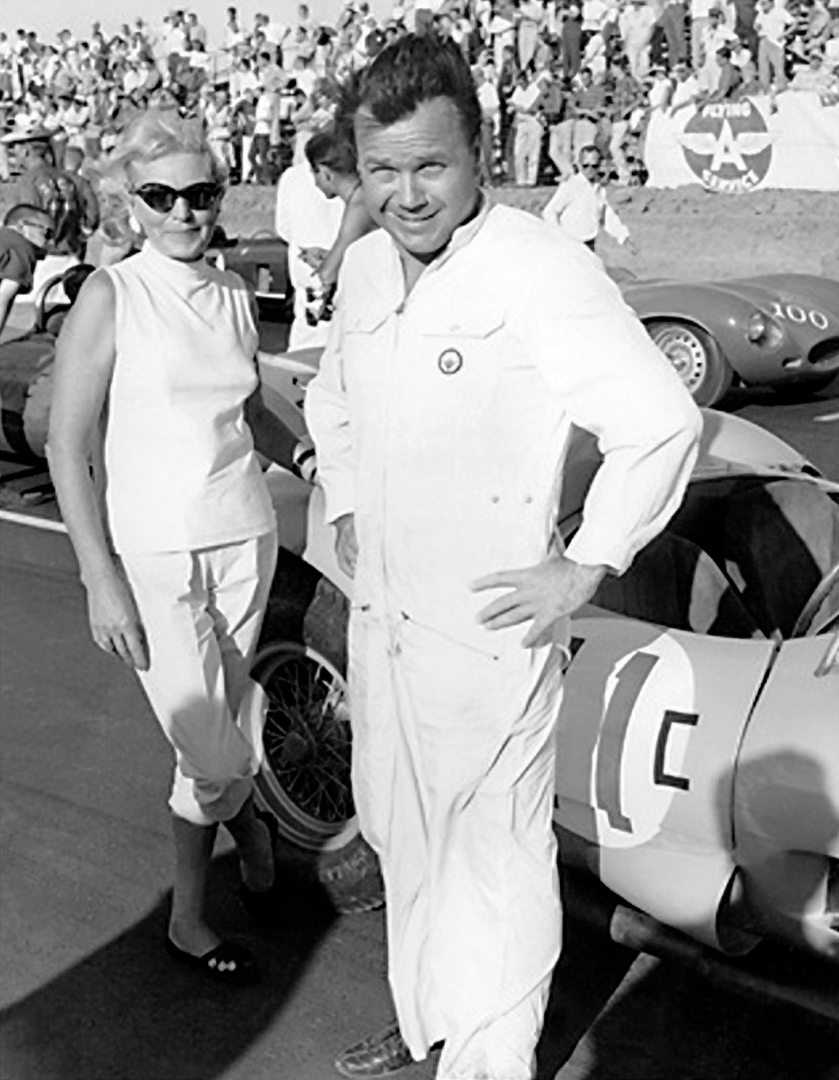
The first Cooper Bobtail sports car to attract much attention in Southern California was an 1100-cc Climax-engined example owned and driven by Lance Reventlow. The first time I spotted the car was at the first running of the Pomona Road Races on June 23-24, 1956. The reason I mention Lance’s car is that Ken Miles noticed it. Ken took it around the course for a few laps during a practice session and I was able to photograph it.
At the time, Ken’s competition in the Von Neumann Porsche was Richie Ginther in another Von Neumann Spyder and Bob Drake in a Cooper Bobtail. Ken thought the Bobtail handled better than the Spyder. Not only that, it was lighter. Always wanting to win, Miles got the idea of installing a Porsche engine in a Cooper, so he persuaded Johnny to buy one.
Von Neumann ordered a Bobtail sans engine and gearbox from John Cooper in England. When the roller arrived at Competition Motors, a Vasek Polak-prepared 4-cam engine and ZF gearbox were installed. Johnny entered the Porsche-Cooper for its first outing at Paramount Ranch on November 17-18, 1956. The press predicted an epic battle between the Porsche-Cooper with Ken Miles up and the Cooper-Climax driven by Bob Drake (entered by the Cooper importer, Joe Lubin). Miles posted a lap at 1:36.858, an all-time, never broken record at that track. Foretelling what was to come, the best Drake could do was 1:42.762, and Miles won the main event.
The December Nassau Speed Week was the final event in the 1956 season. Von Neumann entered the Porsche-Cooper for Miles in the 20-lap Governor’s Trophy race for under two-liter cars as well as the main event. Traditionally, Nassau attracted some of the best from both sides of the pond. In the under-two liter race, Miles finished 2nd to Howard Hively in a Ferrari, ahead of Ed Crawford in a Porsche and Masten Gregory in another Ferrari. Stirling Moss won the main event in a 3-liter Maserati with Masten Gregory and de Portago 2nd and 3rd, both in Ferrari Monzas, but there was Ken and the Cooper in 4th among all the big dogs. The Miles finish at Nassau raised a few eyebrows at the Porsche factory. Nassau wasn’t just some local club event. Here was their West Coast U.S. distributor entering a Cooper in a world-class event and besting all the Spyders!
The first West Coast event for 1957 was held January 19-20 at the Pomona Fairgrounds. The long-awaited duel between the Miles and Drake Coopers took place in both under-1500-cc semi-main events. It was Miles all the way in the pouring rain with Drake following by 6.8 seconds on Saturday and 21 seconds on Sunday. Road & Track called the Porsche-Cooper “amazing.” Afterward the short saga came to an abrupt halt. Von Neumann was ordered by the factory to stop entering the Cooper. So he sold it to Stan Sugarman of Scottsdale, Arizona, sans the 4-cam engine.
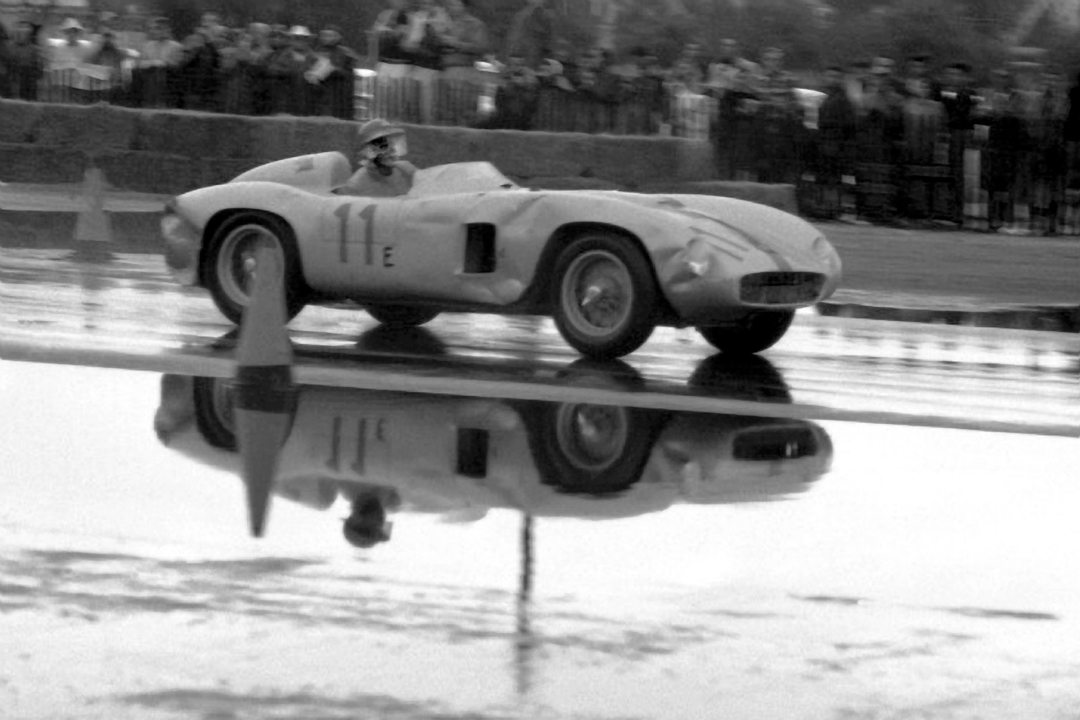
During his Von Neumann tenure, Miles scored 41 podium finishes, 24 1sts and 12 2nds. (Ken would have stood on a podium had podiums been used at the time.) The association came to a parting of the ways, however, at the end of 1957. The first Riverside event—organized by the Cal Club, of which Miles was then president—was scheduled for September 21-22. Ken wanted very much to run. Johnny, however, was in Europe at the time and had left word that none of his cars were to be raced while he was away. Miles resigned in anger and went with Otto Zipper, for whom he raced Porsches from then on. (According to Michael Lynch, at one time Otto dated one of Johnny’s sisters.)
One occasion I can recall in some detail was one of those usual end-of-the-year dinner-dance banquets put on by the Cal Club. I had a date with Josie Von Neumann. (We didn’t have any romantic interest in each other; we were just good friends.) We went with John and Elinor, the four of us sitting together. After the meal, I asked Josie to dance, but she didn’t enjoy dancing. John was very quiet; I don’t think he and Elinor were getting along too well then. So I asked Elinor to dance and we more or less danced the night away. As a former Ziegfeld Follies dancer she was perhaps the best I had ever danced with. (I was sort of picky since one of my very early jobs was teaching dancing at Arthur Murray’s.)
In 1957, Von Neumann added a Ferrari franchise to his empire—called the Ferrari Representatives of California—managed by Richie Ginther. In 1959, John and Elinor parted ways. His Ferraris and the Ferrari business went to Elinor in the divorce settlement. (She died in 1990.) Phil Hill drove Elinor’s 250TR/59 Ferrari to victory at the Los Angeles Times Grand Prix at Riverside in 1959.
Johnny himself continued to race Ferraris until the end of the ’50s, after which he hung it up. His best year behind the wheel was 1957. He raced all over the country, scoring 13 overall or class wins. He even ran two events in Europe and won Avandaro, Mexico, on April 7, as well as a heat race at Nassau on December 6. His very last race was at Avandaro on April 26, 1959 in his Ferrari TRC.
Richie Ginther and Josie Von Neumann continued to race Ferraris, now for Elinor. Josie had stopped entering ladies races and competed in main events. I remember racing with Josie at Hourglass Field near San Diego in June 1959, me in my Devin SS, Josie in her mother’s Ferrari 250TR. We were going at it hot and heavy when my brakes started to fade. Eventually she passed me, pulled away and finished 4th overall. When I pulled into my paddock, Josie came over, asked what happened and commiserated with me. She was not only a competent driver, but also a good and caring person. She ended up marring John McLaughlin, who used to work for me at Evans Industries. After the ’50s, Josie and I sort of lost touch with one another. Last I heard, she had moved to Ojai and died in 1997.
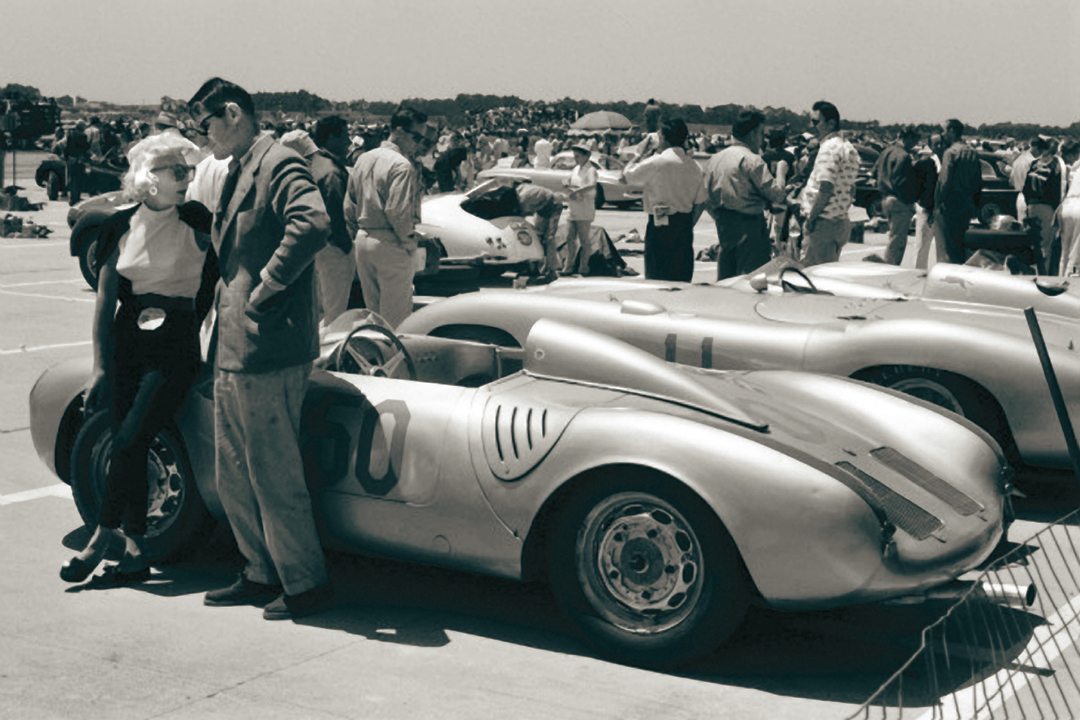
During the ’60s, John’s Competition Motors acquired a 13-acre distribution center in Culver City, sending more than 70,000 cars to 144 dealers in 1968. One-third of all the Porsches sold in the U.S. and one-sixth of Porsche’s total production were distributed by Von Neumann that year. In 1971, Johnny sold out to Porsche and Volkswagen, joining the ranks of the super-rich.
Not content to rest on his laurels, Johnny acquired the Ferrari distributorship for Switzerland, established a Piper aircraft dealership in Los Angeles and imported Pipers to Switzerland. He was also a partner in a Learjet leasing enterprise, as well as the importation of yachts from Italy. Warren Olson told me that Johnny was a jet pilot and remembers that he flew with him in John’s French MS. Everything Von Neumann did seemed to turn to gold.
In 1985, I was involved in organizing the Palm Springs Vintage Grand Prix in remembrance of those races we had there long ago. The big event on Saturday was the Fabulous Fifties Reunion, a parade of more than 50 drivers who had raced during the ’50s, hopefully in the same or similar cars. Very few had appropriate cars, so I set about borrowing from vintage entrants. Most appropriate for Johnny was Ron Kellogg’s Ferrari Testa Rossa. John had raced that actual car at many ’50s events.
John showed up on Saturday before the Reunion event. I took him to Kellogg’s paddock and introduced them. John said he wanted to re-familiarize himself with the car so Ron gave him the key and Johnny drove off. The time for the event rolled around and no Johnny, so the group took off without him. Hours later, as the sun was starting to set, John returned with a wide grin on his face. He thanked Ron and left!
On Sunday, Race Seven was for older sports cars. The cars were due to line up at pre-grid, but an official hustled me over to their paddock. All of the drivers were suited up but sitting on the concrete beside their cars. Vasek Polak had entered his 1937 BMW 328 for John Von Neumann to drive. When I got there I was told that the entrants wouldn’t compete against a replica, which, in fact, the BMW was. I talked with Vasek about it and he admitted it was a replica, but, he said, “It’s an exact replica.” I had to pull the BMW and the drivers climbed into their cars. Vasek was upset with me, but Johnny didn’t seem to care that much.
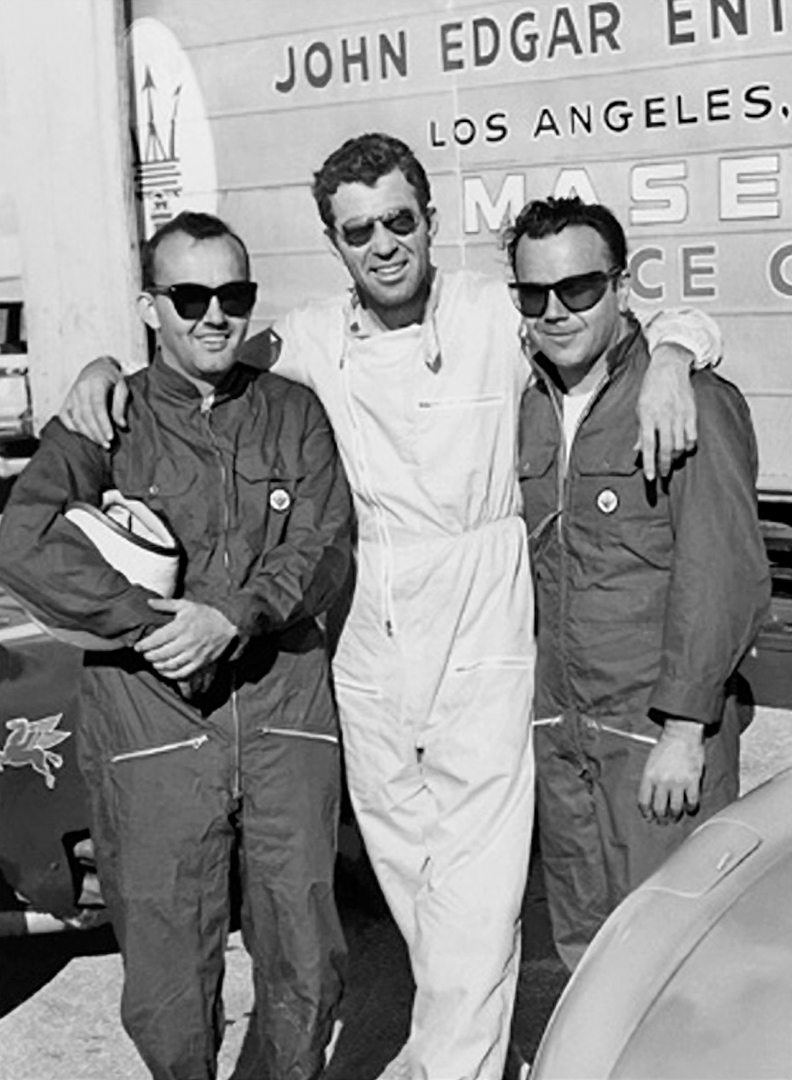
In 1986, I was involved in helping put on a vintage open-road race in Mexico. The course was from Ensenada, across the peninsula to San Felipe. The starting line was a mile or so outside Ensenada. As we were setting cars off at one-minute intervals, Johnny drove up to the head of the line in a new Ferrari with Vasek Polak riding shotgun. He hadn’t sent in an entry form and the event was for vintage cars. Nevertheless, I sent them off and I remember they had a grand old time at the party afterward.
In 1987, John married Monica Potter, with whom he had a daughter, Dorian. When Johnny died, Monica apparently inherited all of John’s wealth. Born in Detroit, she had moved to Los Angeles to be a dancer and model. She said that Sonny Bono, then mayor of Palm Springs, introduced her to John. These days she goes by the name of “Baroness Monica von Neumann,” the widow of “Austrian Baron John von Neumann!” (Note the lower-case “v” indicating inherited nobility!)
Shortly after the marriage, John had an affair with a Charlotte Vega. A separation between John and Monica ensued. In 1989, Charlotte gave birth to a son she named John, claiming John was the father. In 1991, Johnny obtained a default judgment (affirmed on appeal) that he was not the father. According to Charlotte, however, “John Von Neumann acknowledged my son as his son and provided support until his death.” The son, who goes by the name of John Von Neumann II, claims to remember living with Johnny and calling him “dad.”
One time a few years before his death, Johnny told me about what he called his “boat” harbored in Monaco. It was actually a ship complete with captain, crew and chef. He said it was one of the fastest in the world capable of speeds in excess of 50 knots. At that time he not only had a chalet near Geneva, but also the Rose Avenue house in Palm Springs and an estate in Bel Air (near Los Angeles).
As I recall, there was usually one comely young lady or another living in the Palm Springs house. They would sometimes accompany Johnny to parties at my house. I vaguely seem to recall Monica visiting on occasion. One time John had me come to take photos of a girl named Lucilla, a model from Morocco, posing with his latest Ferrari. Later, I heard from historian Michael Lynch that Johnny had set her up in a boutique in La Jolla, a neighborhood of San Diego.
In 1997, we were having a banquet at the Petersen Automotive Museum to commemorate the 50th anniversary of the founding of the Cal Club. John was then the only one still living among the three founders, but he wasn’t there. About half way through the ceremony, he came in and sat next to me. He had just returned from Europe and had come directly from the airport.
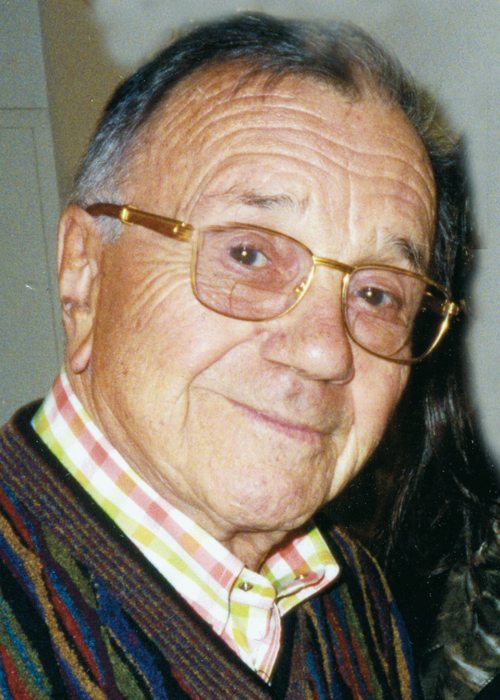
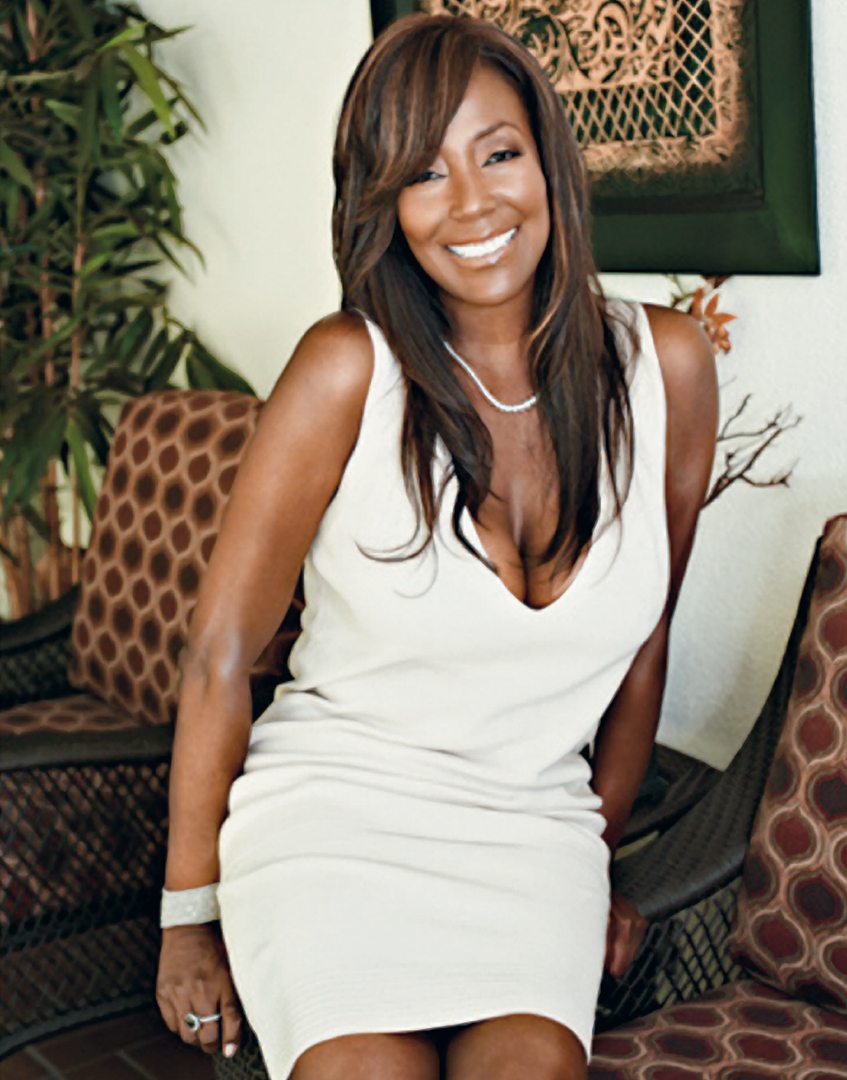
The last time I remember seeing Johnny was on the day we christened my grandson in July 2002 at the Catholic Church in Palm Springs. After the event we had a party in our house. John was the first to arrive and the last to leave. Afterward he took my wife and kids for a long ride in his new top-of-the-line Bentley. My wife was particularly fond of Johnny and she had me hang his portrait on the wall after his death.
Depending on his mood, Johnny could be either taciturn or loquacious. At the christening party, he talked on and on into the night. On another occasion when we were all playing in the pool, we heard a motorcycle drive up. John in his leathers came and in sat by the pool, not saying a word. After a while, I told my son, David, “Go and get Mr. Von Neumann a beer.” He drank it, sat for a while longer and then rode off on his bike, still never having said a word. (John and Vasek Polak would often go dirt biking in the desert near Palm Springs before it became so developed.)
John Michael Neumann died on Christmas night, 2003. John’s widow, Monica, reserved the Petersen Automotive Museum for Sunday April 25, 2004 for a “Celebration of the Life of John Von Neumann,” but a few days before the date, abruptly cancelled the affair without any explanation and left for Europe.


